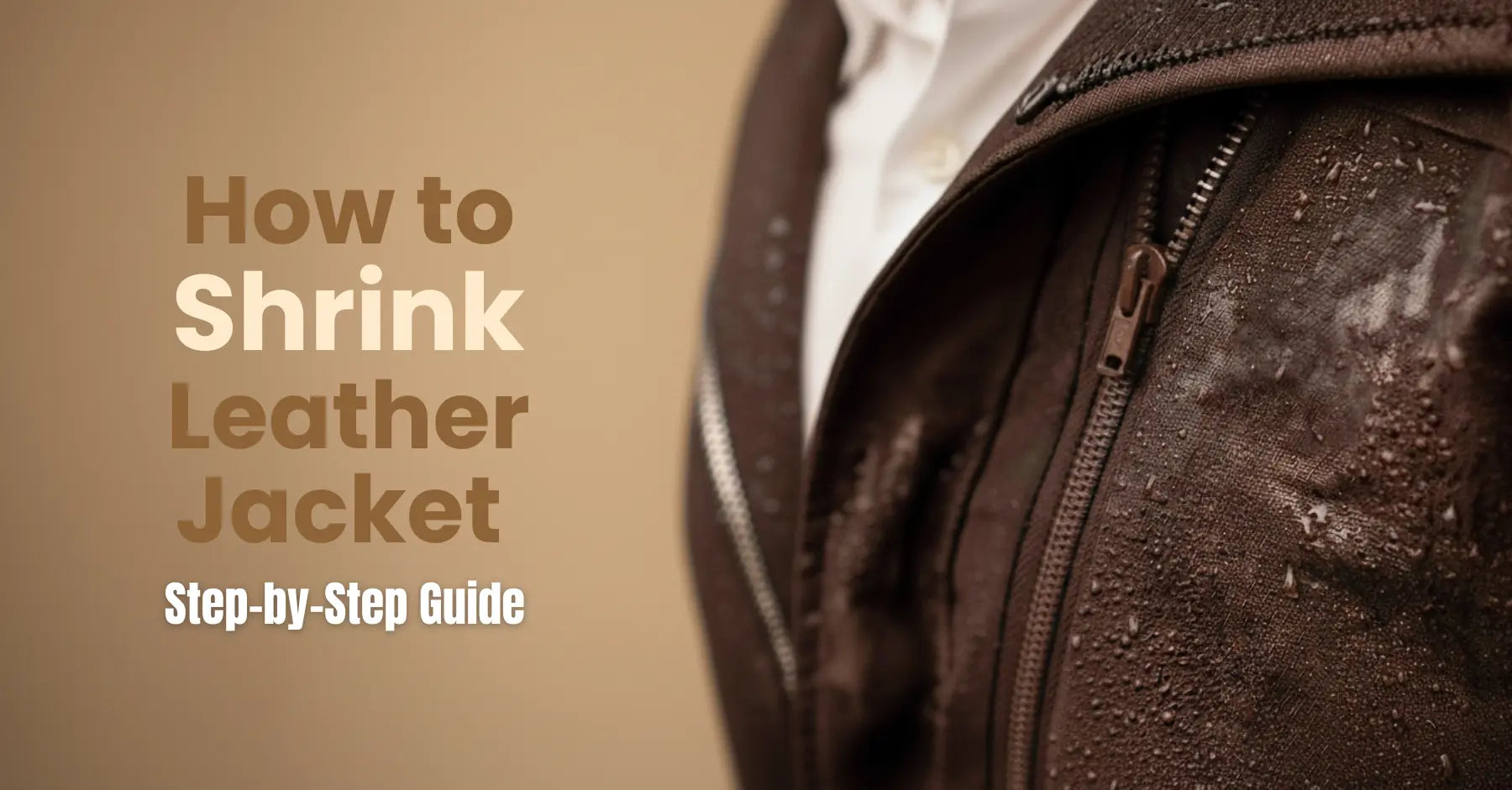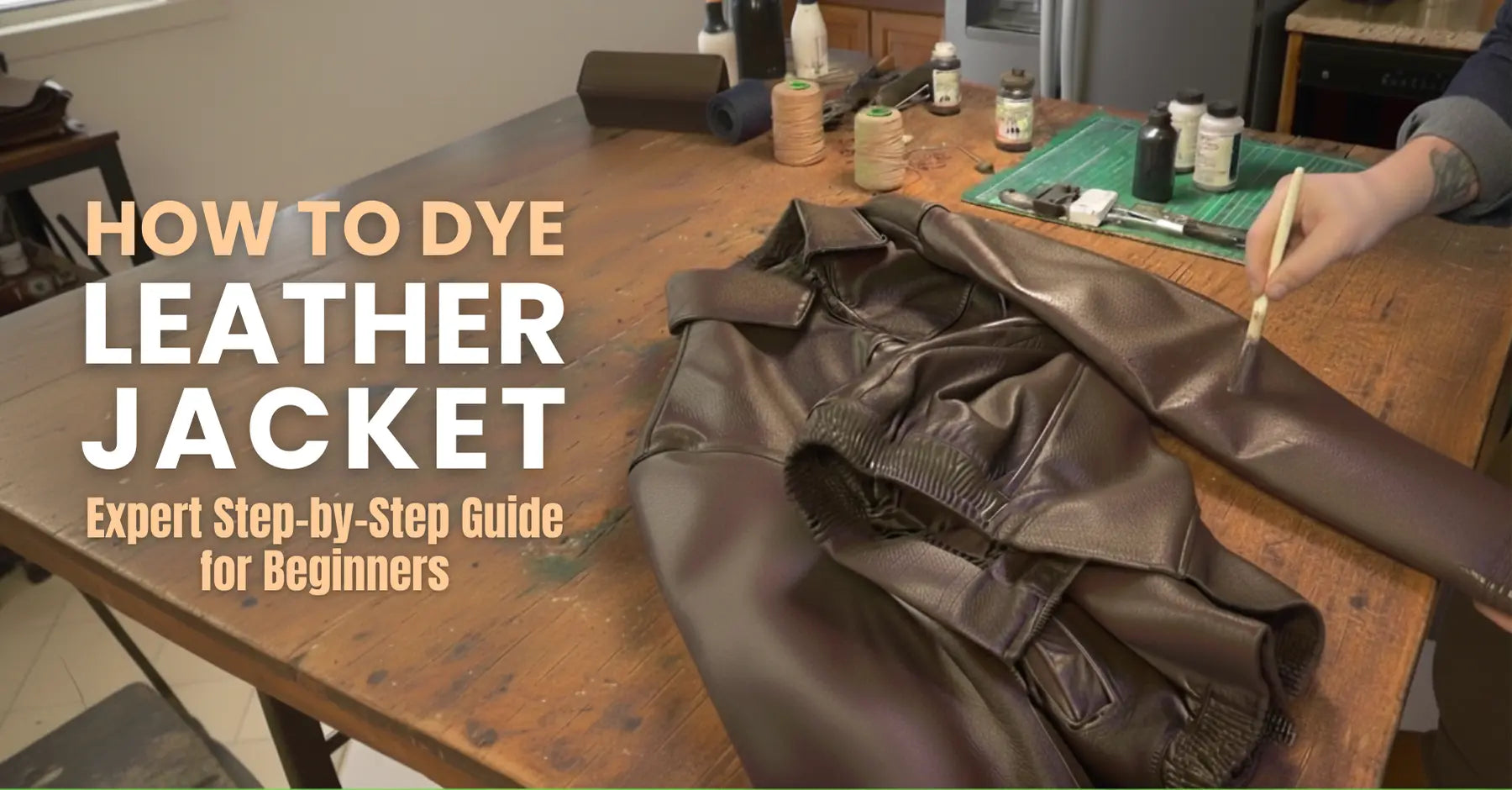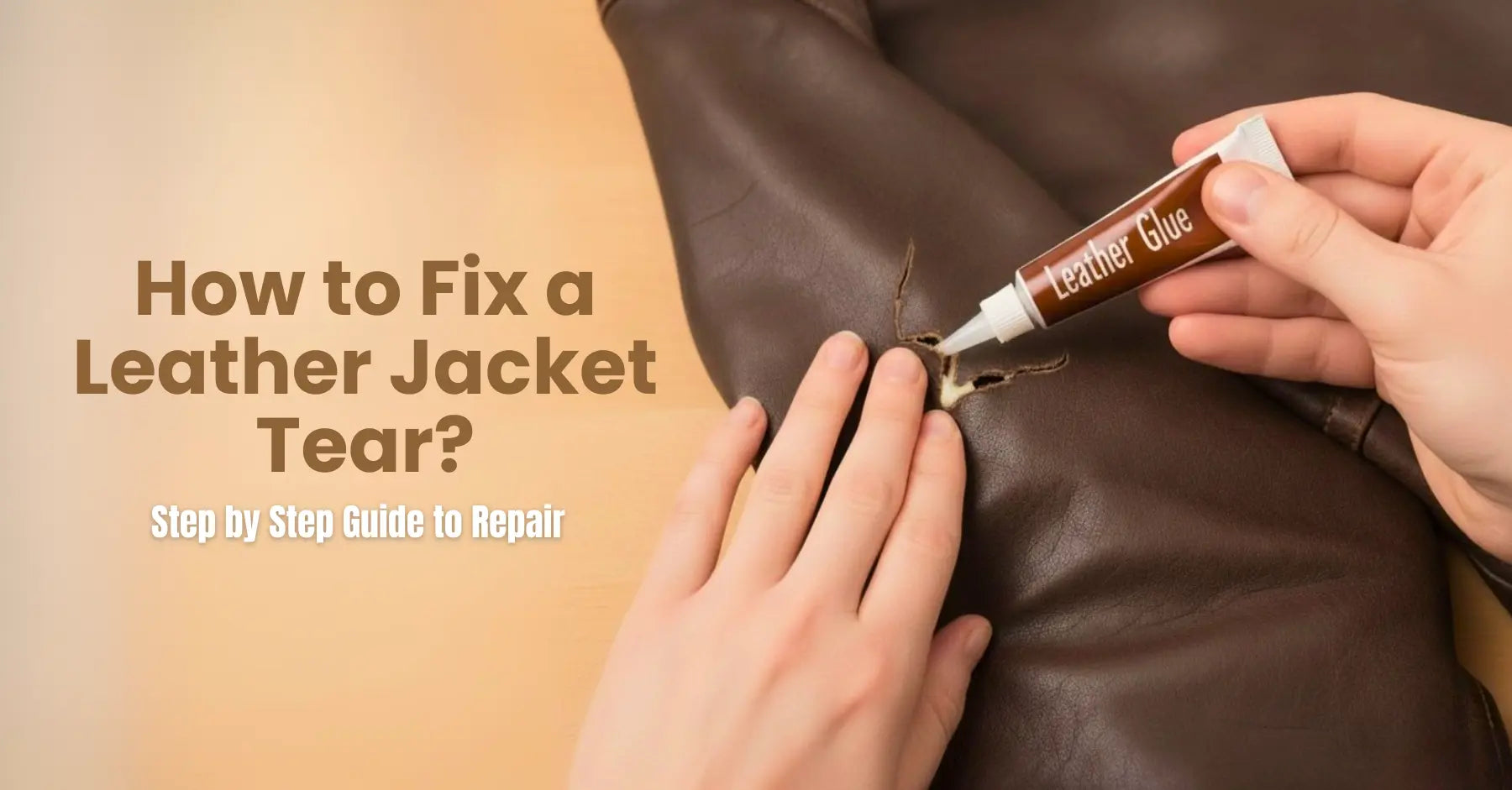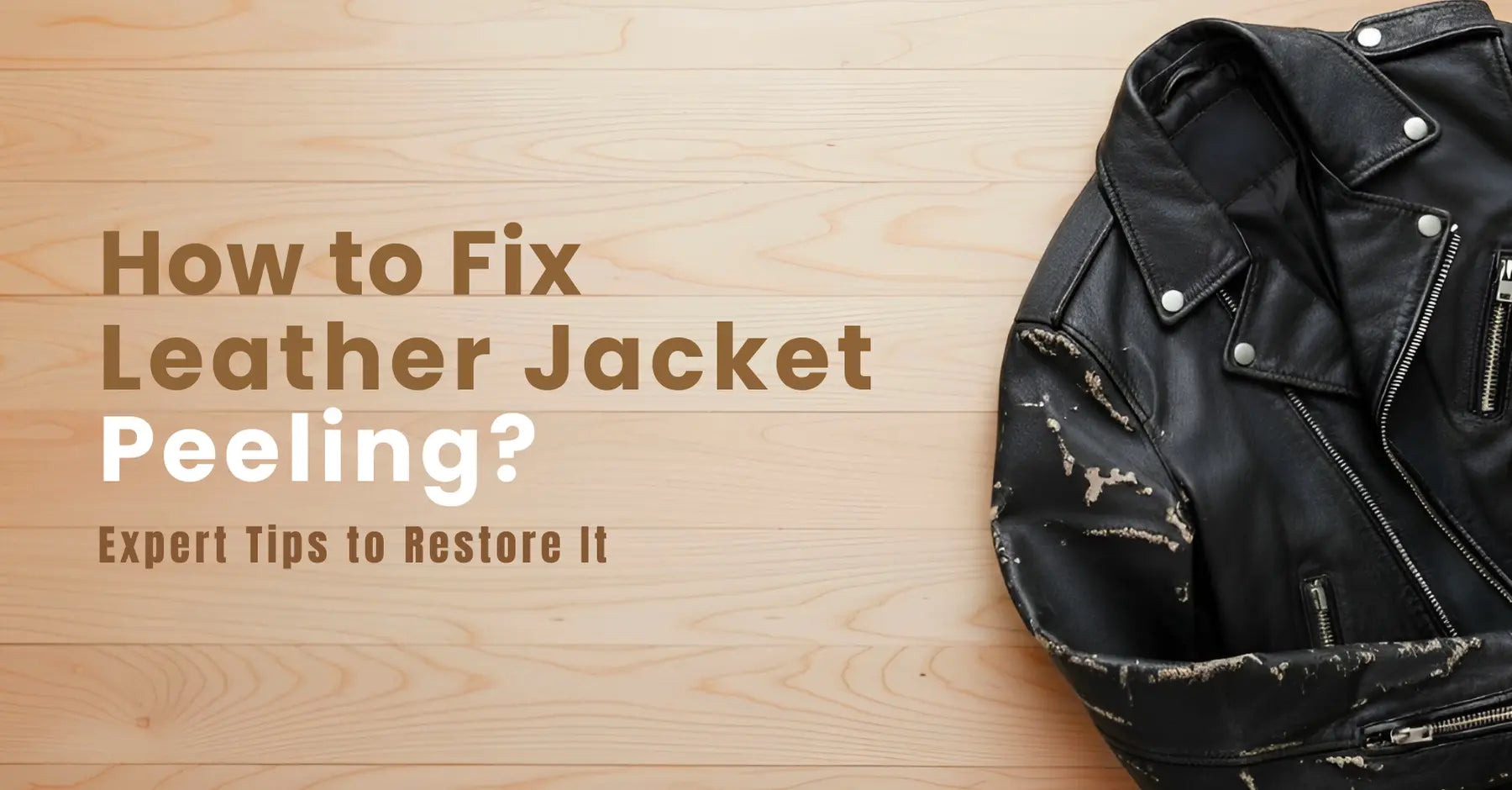Yes, tailoring a leather jacket is possible. However, because leather is less forgiving than fabric, even small adjustments depend on the jacket’s type, design, and structure. Simple adjustments, such as shortening sleeves or taking in the sides, are possible, while bigger changes need skill and care.
During online shopping, it’s hard to touch, interact with, or feel the jacket through a touch device, making size determination a real challenge. Experts suggest that, always consider if alterations are necessary before buying, imagine the fit, and the real look to avoid problems.
Can You Alter a Leather Coat Without Damaging It?

Yes, leather coats can be altered, but it's much harder than with other fabrics due to their tight seam placements, intricate designs, and inner linings. A skilled tailor is needed to adjust the lengths, maintain proper proportions, and ensure a balanced look with precision. Altering leather jackets takes care, as the material doesn’t forgive mistakes and often requires more time for longer changes.
Can a Leather Jacket Be Tailored to Fit Bigger Sizes?
If you're thinking about making a leather jacket bigger, a well-trained tailor with the right expertise can help. A skilled tailor can assess your jacket and decide how to attach extra material or adjust seams, ensuring your jacket fits better without losing its style.
When deciding whether to proceed with the alterations, it’s important to discuss the matter with your tailor. Their professional advice and tips can help you understand the process and what to expect. In my experience, making these adjustments gives your jacket a new life, making it more comfortable and stylish.
How Do You Know If a Leather Jacket Is Tailorable?
The material and quality are the decisive factors in determining whether your leather jacket can be altered. Jackets made from full-grain cowhide, sheepskin, or lambskin are more suitable for alterations. Simple designs like bomber jackets or cafe racers are easier to work with.

Check for well-made seams and avoid glued sections as they can complicate resizing or reshaping. Minor tweaks, such as sleeve shortening or taking in the sides, are possible with an experienced tailor who understands the jacket’s structure.
Check the Fit and Areas of Concern:
To assess your leather jacket fit, focus on areas like the shoulders, arms, waist, and chest. A tight or loose jacket can feel uncomfortable. Check if the shoulders are too wide or restrictive, and if the sleeves are too long. Ensure the waist and chest aren’t too tight or have excess material. Small amendments like having it taken in or adjusting sleeve length are often necessary for a better fit.
Check the Leather Type:
Always check the leather type first. Cowhide is a thicker material, making reshaping or resizing more difficult. In contrast, lambskin leather is softer and easier to work with. The thickness of the leather impacts how easily it can be altered, so always consider the leather type before attempting any tailoring.
Examine the Seams and Stitching:
When considering leather jacket resizing, always examine the seams and stitching for weak stitches or loose stitches. These can cause issues if not addressed properly. Leather is a tricky material to alter, requiring a well-trained tailor with the right experience. Poor stitching patterns or sharp edges can ruin the jacket, so it’s crucial to carefully handle the material to ensure it will survive over time.
Key Factors That Affect Leather Jacket Tailoring:
A skilled tailor can adjust your leather jacket, but success depends on the leather type and complexity of changes. Simple fixes like hemming are easier, while resizing needs real expertise. Cheap fixes risk quality. Set realistic expectations and check an alteration cost guide before choosing an experienced professional.

Leather Type:
When refitting a leather jacket, the type of leather matters greatly. Cowhide and horsehide are thicker and require leather needles for proper stitching, while easier to cut, faux leather is prone to damage and difficult to re-stitch cleanly. Using the right needles, like denim needles for tougher fabrics, ensures clean holes and strong seams without damaging the material.
Style:
Yes, you can tailor a leather jacket, but the difficulty depends on its structure. Simple leather jackets with just pockets or ribbing are easier to alter, while complex jackets with zippers, insulation, or layered liners are tougher. I know that altering these requires skill and time; some designs are hard to recreate.
The style is a key determining factor; jackets like aviator jackets with reinforcements can limit how much can be altered without compromising authenticity.
Skill Level:
Altering a leather jacket requires a high skill level; this isn’t beginner-friendly work. The right equipment (heavy-duty needles, leather-specific supplies) is essential, as pins leave permanent holes in this delicate material. Professional tailors understand the nuances of leather, while inexperienced ones risk ruining the jacket.
Stitching, Seams & Hardware:
Stitching, seams, and hardware also affect how successful the alterations are, ensuring the jacket still fits comfortably and looks great.
Budget and Expectations
Altering a leather jacket requires a skilled tailor experienced in this delicate process. Expect higher costs; quality work doesn’t come cheap. Communicate your preferences clearly and discuss pricing upfront. A trustworthy professional ensures precise, long-lasting alterations for the perfect fit.
What Changes Can You Make to a Leather Jacket?
Yes! A leather jacket can be customized for a better fit, size adjustment, or style upgrade. Tailors can slim the sides, shorten sleeves, or make changes like adding zippers to enhance functionality and look. Even small modifications like reshaping the collar or replacing hardware can refresh your jacket dramatically. Just ensure your tailor works with leather.
Leather Jacket Fit Adjustments:
A tailor can refine your off-the-rack leather jacket for a perfect fit, elevating both comfort and confidence. Whether you prefer a classic cut or a bold, trendy oversized look, expert tailoring ensures your jacket doesn’t just fit, it becomes a sharp, personal style statement with a modern edge, molded uniquely to you.
Functional Modifications:
Yes! A leather jacket can be tailored for better functionality and style. Zippers can be replaced or upgraded if damaged or outdated; a new zipper improves usability. Buttons can be swapped, like silver buttons for an antique look, or changed to refresh the vibe. Pockets can be adjusted, repositioned, or resized to enhance fit and appearance. Even small tweaks, like replacing hardware or personalization, can transform its look.
Lining Changes:
Replacing or repairing the lining is a common alteration that can improve both comfort and durability, especially in older jackets. You can choose from different types of lining materials, like breathable cotton or sleek satin, and even add a personal touch with vibrant colors or unique patterns.
Design Customizations:
For a contemporary look, a custom jacket can be styled with studs, pins, contrast stitching, patches, or embroidery. Adjust the collar, cuffs, or hemline, or add embossing to boost your style quotient. Every detail personalizes it.
Leather Jacket Alterations Tips: What You Can Change:
A skilled tailor can adjust your leather jacket for a sculpted fit, but not all alterations are suitable. Common changes include sleeve adjustments, taking in the sides, or hem shortening. Since leather is tough, each step requires expertise. DIY tips may ruin the jacket. Always consult a pro for the best results.
Sleeve Adjustment:
Shortening or lengthening a leather jacket's sleeves is possible but requires skill. A simple alteration like trimming excess leather and reattaching cuffs can fix long, sloppy sleeves, though the cost is higher than typical adjustments. For best results, leave this alteration to professionals.
Waist and Body Adjustments:
It was observed that a waist adjustment can instantly improve the fit. Tailors often work on the side seams or the center seam to make the jacket tighter, more fitting, and firm. They may remove extra fabric or even add material if needed. These alterations shape the seams, enhance the overall silhouette, and give a sleek, modern look without compromising comfort. A small alteration goes a long way in refining the jacket’s style.
Shoulder Adjustments:
Shoulder Adjustments on a leather jacket are a complex task that involves altering the shoulder seam, often by removing and reattaching the sleeves. Whether your shoulders are too wide or too narrow, these adjustments help improve the fit but require a high level of professional tailoring. You can’t just tinker with it; any change needs precision.
Length Adjustments:
I once had a leather jacket that looked great, but the length ruined the fit. A good tailor helped fix it by shortening it, which is easier than lengthening, since new material can’t just be added. With leather, precise length adjustments matter, and only an expert can handle this material correctly to keep the jacket looking sharp.
Key Takeaways
Leather jackets can be tailored for a better fit by adjusting areas like arm length, shoulder width, chest width, torso height, and waist. It’s usually best to leave these adjustments to professionals, though it may be easier to tailor if the changes are smaller or larger. A tailored jacket will offer a more comfortable, stylish look.
Step-by-Step: How to Tailor a Leather Jacket
An expert leather tailor uses special tools, such as a leather sewing machine and leather cutters, to make clean and precise cuts in a leather jacket.

The tailor must assess the jacket's structure and make required adjustments while ensuring the leather remains undamaged. Attention to detail is crucial, as damaged leather can’t be easily repaired. Skilled tailors with advanced skills will make alterations without causing permanent damage, ensuring the leather is preserved for the best results.
How to Tailor a Leather Jacket Step by Step:
- Measure and mark the areas of your leather jacket that need adjusting, such as the sleeve length or hem.
- Use a seam ripper to carefully remove any stitches before making changes to the leather fabric.
- After cutting off any excess material, fold the edges and leave a hem allowance for neat finishing.
- Press the folds gently with an iron to ensure a clean, smooth look before sewing the new hem or adjustments.
- If unsure, consult a professional leather tailor for a more precise and refined cut, ensuring the job is done right.

Timing and Process:
When customers send their jacket for resizing, the whole process, from shipping adjustments, usually takes about 1-2 weeks.
What Does the Leather Jacket Tailoring Process Involve?
Resizing a leather jacket involves careful assessments and adjustments to achieve a custom fit. It's all about ensuring precision and quality in every modification.
- Adding material for extra comfort or style
- Resizing and alterations for a better fit
- Expansion areas for a more relaxed look
- Finessing for perfection and craftsmanship in the final result
Assessment of the Leather:
When tailoring a leather jacket, the first step is an assessment of the leather. The material is tricky to handle, and a skilled, experienced tailor must carefully examine the surface to determine the best approach. It's important to select the right techniques, ensuring the leather remains intact while achieving the desired fit.
Expansion Areas:
A skilled tailor can adjust the sides, shoulders, and sleeves of a leather jacket if there's enough room. They will understand how to open these areas and adjust them accordingly. Be sure the space in these areas allows for the changes you want, without damaging the leather.
Adding Material to the Leather Jacket:
A tailor can adjust your leather jacket by adding extra leather to make it bigger or more spacious. The extra leather is strategically selected to match the color and texture of the original, ensuring the exact leather fits closely with the jacket’s shape. This allows for an enlarged or cropped fit while maintaining the original look and preserving the matching style.
Adjustments in the Leather Jacket:
A skilled tailor can make adjustments to your leather jacket, but leather is less forgiving than fabric. If the jacket is too tight, extra leather may be inserted along the present seams for expansion, but this depends on available room. Making it bigger is harder; leather can’t just be re-sewn without risk. Taking it in is easier, but changes must not hurt the jacket’s structure. The key is to enjoy a better fit without compromising the overall look. Always choose an experienced leather specialist.
Finessing the Leather Jacket:
A skilled tailor can alter your leather jacket, but with limits. They can fine-tune the fit by taking it in or adjusting seams, though making it bigger is tricky - leather doesn't stretch, and you can't replace the hide. Removing extra material creates useless leather scraps. For a high-quality jacket, precise alterations can make it perfectly comfortable. Choose an expert - leather forgives no mistakes.
Basic Tips to Tailor a Leather Jacket:
We recommend these basic resizing tips to achieve the sculpted fit for your leather jacket.

Check the Fit:
A good fit is key for leather jackets; too tight restricts movement, too loose looks sloppy. Check the shoulders, waist, and sleeve length; they should lie flat, taper slightly, and end at your wrist. A snug fit keeps it sharp yet comfortable. Minor alterations can adjust the fit, but cutting leather requires expert hands. I’ve seen rushed jobs ruin good jackets. Always inspect key areas and get a pro’s touch for the best results.
Measure Accurately:
Yes, a leather jacket can be altered, but measure accurately the chest, waist, shoulders, length, and sleeves because inaccurate cuts ruin the fit. Leather doesn’t stretch, so exact measurements are key. A good tailor can alter it effectively, but only with the correct details. Skip this step, and you’ll waste a fine jacket.
Altering Sleeve Length:
Yes, you can adjust the sleeve length of a leather jacket, but it’s trickier than other alterations. If the sleeves are too long, a skilled tailor can cut sleeves to your desired length and reattach cuffs for a clean finish. The ideal fit hits just above the wrist bone for a flattering look. I’ve seen jackets ruined by poor sleeve adjustments, so I always choose an expert who knows how to handle leather.
Sew with Leather Needles:
Always sew a leather jacket with leather needles, never a regular sewing needle, as it can break or damage the thick leather. These specially designed needles pierce cleanly, ensuring a seamless finish. From experience, using the wrong needle ruins the material, while the right one makes sewing smooth and professional.
Use Chalk for Marking:
For clean, temporary markings, use chalk or a fabric marker that wipes away easily without leaving a trace. This way, you can make precise adjustments without worrying about permanent stains or damage to the leather. Perfect for flawless alterations every time!
Leather Cutting:
Yes, but leather cutting demands sharp tools, steady hands, and focus. First, mark precise alteration lines with chalk, then carefully cut along them using heavy-duty scissors. Improper cuts can ruin the leather.

Advanced Tips to Tailor a Leather Jacket:
Here are some expert tailoring tips for making significant alterations to your leather jacket, perfect for achieving a custom fit or major style changes.

Add or Remove Lining:
Add or Remove Lining from a leather jacket for better comfort. Swap the lining with breathable fabric like silk or satin in this advanced alteration. A new lining must be sewn carefully to avoid discomfort or an uneven appearance, so rely on professional tailoring. Though lining tailoring is difficult, it ensures the jacket fits perfectly after the change.
Replacing Zippers and Hardware:
Yes, replacing zippers and hardware on a leather jacket is doable. An old zipper can be swapped without damaging the leather; just detach the worn one and securely sew in a new one. Choose durable brass or steel hardware to ensure your jacket lasts. While it’s one of the simple tasks, precision matters to keep the fit intact.
Lengthening the Jacket:
Lengthening the jacket is an advanced task, especially when working with a leather jacket. To extend jacket length, a skilled tailor must carefully assess the previous material and match it with a specific kind of leather; mismatched textures or colors can ruin the look.
One method involves adding leather panels at the hem or sides, but this can be tricky since stitching must blend seamlessly.
Another approach is inserting a new panel, but this requires precision to maintain the jacket’s original shape. Not all tailors can handle this specialized expertise is key.
Advanced Seam Work:
Tailoring a leather jacket requires advanced seam work, especially for the chest and arms. If the fit feels odd or uncomfortable, a tailor adjusts the seam width using tools like a leather sewing machine and a specialized presser foot. Precision is key; poor seam work can ruin the jacket.
Remold the Collar:
To re-mould the collar of leather jackets, I’ve found it’s best to soften the leather first using steam, making it easier to reshape and cut without damaging the stitching. A stiff collar can ruin your look, so adjusting the collar design to match your jacket style is key. I once made mistakes by ignoring these precautions, which affected the shaping. Proper tailoring ensures a more stylish, softer finish while keeping the structure of classic collars intact.
The Cost of Leather Jacket Alteration:
The cost to alter a leather jacket depends on the extent of the alterations, the leather type, and your location. Minor fixes usually cost less, while advanced tailoring like resizing can be high. The general range is $40–$150, but you may pay more for complex work. From experience, finding someone skilled in leather tailoring is key for the best results.
Challenges In Alteration Of Leather Jacket:
Tailoring a leather jacket is tough because, unlike woven fabrics, it lacks flexibility. Every puncture made by a needle leaves a permanent hole, so each cut, stitch, or modification must be done very carefully. You need specialized tools and skills to handle leather garments without damaging their original construction.
Altering jackets with intricate details, pocket placements, collars, or zippers, especially biker jackets, is extremely tricky. The structure, patterns, and design are often unique, and any wrong move can ruin the look. Also, high heat, ironing, or trying to change studs or seams can leave the jacket damaged, restricting further alterations or options.
Tailor’s Expertise:
When tailoring a leather jacket, the tailor’s expertise is crucial. A skilled, experienced tailor ensures the right process is followed for perfect alterations. Investing in a good tailor with a solid portfolio and experience guarantees fruitful results without the hassle.
Take the time to search for the best professional for your jacket's alterations to get the most satisfying fit.

Tailoring Tips & Clarifications, About Leather Jacket Tailoring:
Tips for Tailoring a Leather Jacket:
To tailor a leather jacket, measure carefully and use clips or pins to secure the material. A seam ripper can help with adjusting seams. For thick or faux leather, use denim needles. Cut the leather multiple times to avoid mistakes and turn back if necessary to fix errors. This will save time and make tailoring easier.
Clearing Up Myths & Misconceptions:
There are many misconceptions about tailoring leather jackets, with the myth that leather is thicker and more difficult to alter than other materials like cotton fabrics. While basic sizing tweaks may be possible at home, leather tailoring is best left to professionals. The idea that it’s too complicated or that you should leave it to professionals is misleading, as tailoring leather jackets can be done with the right techniques.
My Research on Tailoring a Leather Jacket:
In my research on tailoring leather jackets, according to user trends about their experiences with their owned jackets. I created a poll to see how many had tailored their jackets, including adjusting sleeve length, smaller waists, smaller shoulders, or smaller chests. 23% of responses said they adjusted their jackets for a better fit, and 15% focused on the all-over fit.
However, 8% found it challenging to tailor larger waists or larger chests, while 15% hadn’t had tailoring done at all. 23% hadn’t considered it. This shows that while tailoring a leather jacket can improve fit, it can be tricky.
Post-Tailoring Care for Leather Jackets:
After tailoring your leather jacket, follow these care tips to keep the leather soft, supple, and glowing for a long time. Apply leather conditioner every few months to avoid cracks.
Store it on a padded hanger to hold its shape, in a cool, dry place, away from direct sunlight, which causes fading. Keep it safe from moisture and water due to its sensitivity. If it gets dirty, wipe it gently with a soft cloth to remove dust and dirt. If wet, blot with a dry towel and air dry without pressure or heat.

Conclusion:
Yes, you can! I once had a leather jacket that looked great but didn’t have the perfect fit. After a quick consultation with a professional tailor, the leather jacket alteration gave it the desired size and redefined the silhouette. If you want your leather jackets to be fashionable and enduring style, proper tailoring is key. A good understanding of leather jacket fitting advice helps ensure the fit is done correctly, especially with high-quality materials. If you are shopping online, a small change in fit adds worth every stitch and makes the jacket last. Choose quality, go for the right styles, and never settle for less than the perfect-fitting leather jacket.
FAQs:
Is it worth tailoring a leather jacket?
Tailoring a leather jacket can be a cost-effective, budget-friendly option if it holds sentimental value or doesn't fit well.
It keeps the original style while adding comfort and confidence to your look.
There are considerable benefits to altering your leather jacket instead of purchasing a brand new one.
Is it possible to get a leather jacket altered?
Yes, leather jacket alterations are possible, but they demand precision that ot every tailor can handle. Skilled tailors can tweak the fit with adjustments like taking in seams or shortening sleeves. Modifications such as swapping the lining or updating hardware (zippers, snaps) are doable but costlier. From experience, minor changes work best; major redesigns may not be worth the effort. Choosing expert care matters when altering such a durable yet delicate material.
What can ruin a leather jacket?
Leather loses natural moisture over time, turning dry and brittle, especially with exposure to sunlight and heat, which speeds up damage. Without care, it becomes prone to cracking, ruining its good shape. Conditioning regularly helps maintain its durability. I’ve salvaged stiff jackets just by keeping them nourished.
Can Tailors Make Leather Jackets Bigger?
Tailors can make leather jackets slightly bigger by letting out the seams for more room in the chest or width, but options are limited due to leather’s inflexible nature. Adjusting sleeve length or overall jacket length is even harder longer sleeves require matching the exact color and type of leather, which isn’t always possible. While small size increases work, significant alterations are challenging because leather doesn’t stretch like other fabrics.
Can Larger Leather Jackets Be Tailored To A Smaller Size?
Yes, a leather jacket can be adjusted to a smaller size. A skilled tailor can take in the sides, shorten the sleeves, and adjust the waist for a better fit. However, alterations depend on the jacket's design and material.
Do Leather Jackets Loosen Over Time?
Yes, leather jackets do loosen slightly over time. With regular wear, the material softens and molds to your body, becoming more comfortable while retaining its shape. However, the extent of stretching depends on the leather type and quality.
Can tailors make leather jackets smaller?
Yes, tailors can make a leather jacket smaller by adjusting the shoulders, chest, waist, sleeve length, and sleeve width. If your jacket is slightly too big or oversized, a tailor can save you money compared to buying new, just make alterations simpler for less tailoring cost. For the best fit, especially when shopping for women’s leather jackets, choose a style that needs minimal adjustments.
How hard is it to tailor a leather jacket?
Tailoring a leather jacket requires the right supplies, skill, and knowledge, unlike a simple shirt alteration. Leather is stiff, so fixing a seam demands precision. With practice, it’s possible, but mistakes are costly. I’ve found that patience and the proper tools make the difference.







